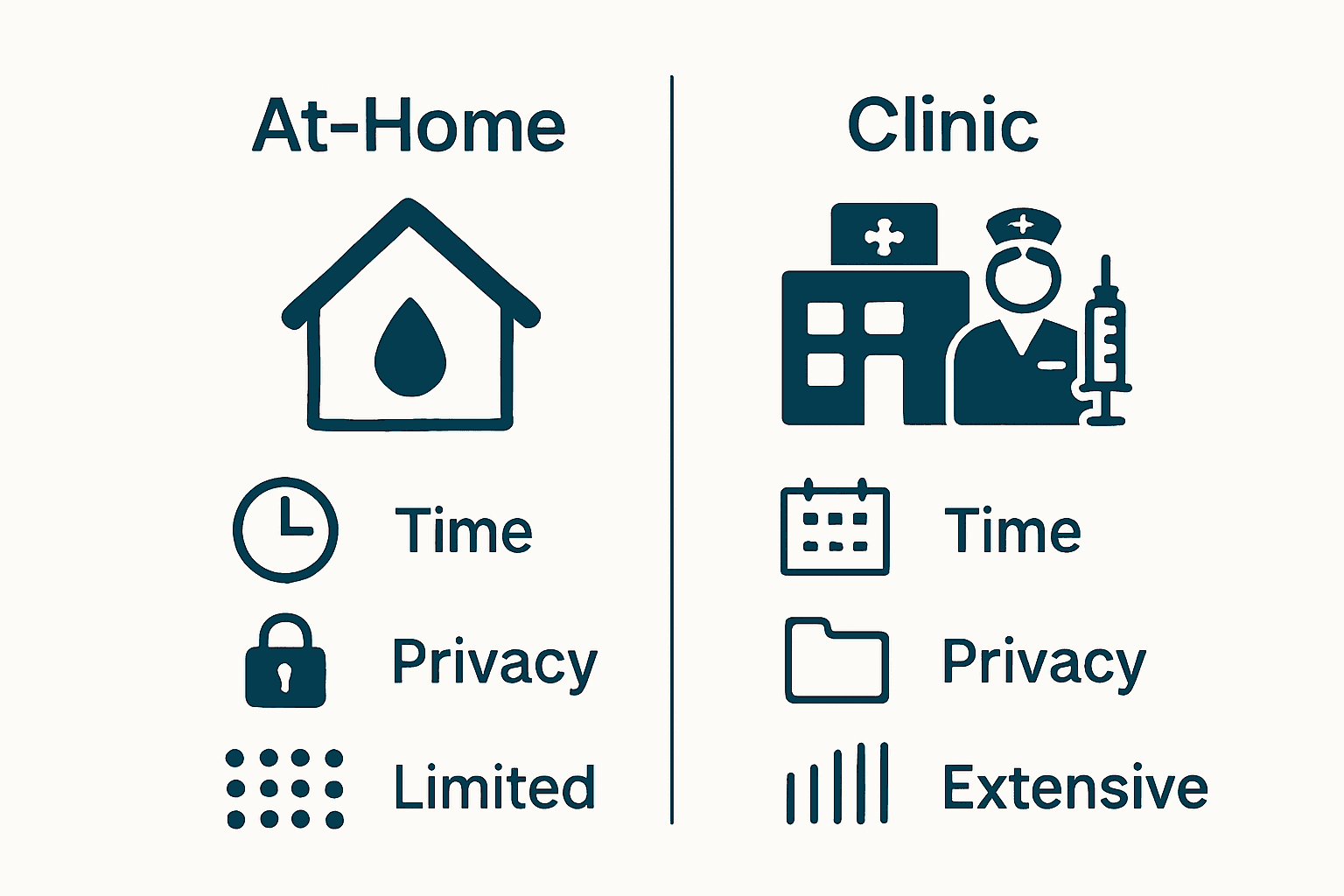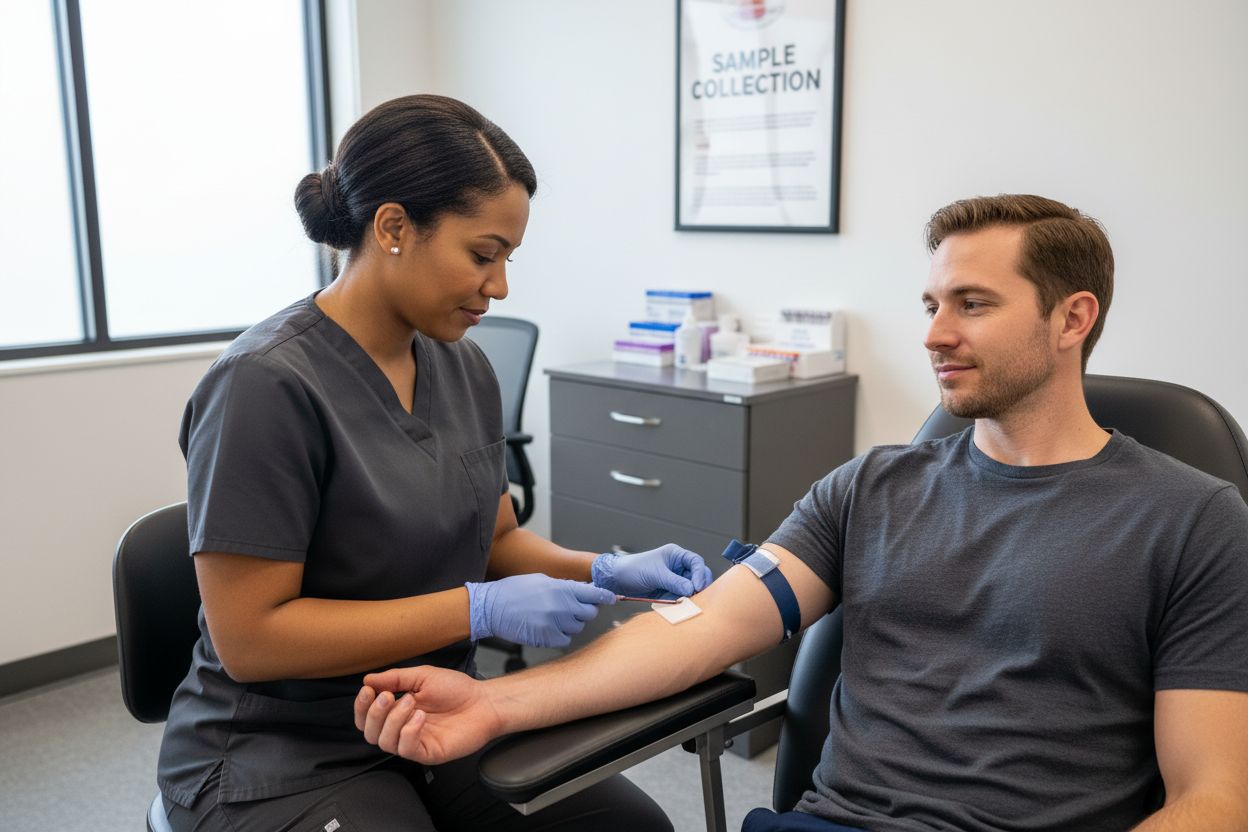Blood tests shape the way we understand our health, and now people can do them without stepping outside their front door. Most wouldn’t expect it, but at-home blood tests have become so effective that research shows they deliver results with nearly the same reliability as those taken in a clinic. While clinics might seem like the obvious choice for accuracy, it turns out convenience does not mean compromise anymore.
Table of Contents
- What Are At-Home Blood Tests And Clinic Blood Tests?
- Why Consider At-Home Blood Tests Over Clinic Tests?
- How Do At-Home Blood Tests Work In Comparison To Clinic Tests?
- What Are The Key Advantages And Disadvantages Of Each Method?
- Understanding The Accuracy And Reliability Of Blood Testing Methods
Quick Summary
| Takeaway | Explanation |
|---|---|
| At-home tests offer convenience | Individuals can collect samples at their own pace and location, removing the need for appointments or travel. |
| Clinic tests ensure accuracy | Professional collection minimizes errors and allows for comprehensive biomarker analysis under medical supervision. |
| Cost-effective health monitoring | At-home blood tests can be cheaper, reducing costs associated with clinics and providing privacy in results. |
| Complementary testing methods | Using both at-home and clinic tests provides a balanced approach to personal health management, merging convenience and professional oversight. |
| User collection can introduce variability | While convenient, at-home tests may lead to user errors affecting accuracy, emphasising the need for careful collection techniques. |
What are At-Home Blood Tests and Clinic Blood Tests?
Blood testing represents a critical diagnostic tool for understanding an individual’s health status, with two primary methods emerging in modern healthcare: at-home blood tests and clinic-based blood tests. Both approaches serve similar fundamental purposes yet differ significantly in their execution, accessibility, and overall patient experience.
Understanding At-Home Blood Testing
At-home blood tests are innovative diagnostic solutions that allow individuals to collect blood samples from the comfort of their personal environment. Research from the British Medical Journal indicates these tests typically involve a simple finger-prick method where users collect a small capillary blood sample using a sterile lancet and specialized collection card or vial.
Key characteristics of at-home blood tests include:
- Self-administered collection process
- Minimal medical intervention required
- Convenient and time-efficient
- Typically covers basic health biomarkers
- Often more affordable than traditional clinic tests
These tests enable individuals to monitor specific health parameters without scheduling medical appointments or visiting healthcare facilities. Learn more about the fundamentals of at-home blood testing, which can provide deeper insights into this innovative healthcare approach.
Clinic-Based Blood Testing: A Traditional Diagnostic Approach
Clinic blood tests represent the conventional method of blood sampling, conducted by trained healthcare professionals in medical settings. These tests involve a venous blood draw, where a phlebotomist extracts blood directly from a patient’s vein using a needle and collection tubes.
Critical advantages of clinic-based blood tests include:
- Professional sample collection
- Comprehensive testing capabilities
- Direct medical supervision
- Ability to conduct complex diagnostic panels
- Immediate handling of blood samples
While more invasive than at-home methods, clinic tests provide a thorough and medically supervised approach to health assessment, ensuring precise sample collection and immediate management of potential complications.
Both testing methods contribute uniquely to personal health monitoring, offering patients flexible options for understanding their physiological conditions and tracking potential health risks.
To help clarify the distinctions between at-home and clinic blood tests, the following table compares their key characteristics, collection methods, and reliability factors.
| Attribute | At-Home Blood Test | Clinic Blood Test |
|---|---|---|
| Sample Collection Method | Finger-prick, self-administered | Venous blood draw, performed by a professional |
| Location | Conducted at home | Conducted in a clinic or healthcare facility |
| Biomarker Coverage | Typically basic health biomarkers | Comprehensive diagnostic panels |
| Cost | Often more affordable | Higher due to facility and professional fees |
| Medical Supervision | Minimal, user-initiated | Direct clinical oversight during procedure |
| Privacy | High, with confidential collection and digital results | Lower, due to presence of staff and handling |
| Accuracy/Reliability | Nearly comparable, but user error possible | High, due to professional protocol |
| Turnaround Time | Rapid, after postal submission of sample | Variable, often depends on clinic processing times |
Why Consider At-Home Blood Tests Over Clinic Tests?
Personal health monitoring continues to evolve, with at-home blood tests emerging as a transformative alternative to traditional clinic-based testing. These innovative diagnostic tools offer significant advantages that address contemporary healthcare challenges, providing individuals with greater autonomy and convenience in managing their wellness.
Convenience and Accessibility
Research from the NHS demonstrates that at-home blood tests dramatically reduce barriers to health monitoring. For individuals with demanding schedules, limited mobility, or those residing in remote areas, these tests provide an unprecedented level of accessibility.
Key convenience factors include:
- No appointment scheduling required
- Testing possible from personal environment
- Elimination of travel time and waiting rooms
- Flexible timing around individual schedules
- Reduced exposure to potential healthcare facility infections
The ability to conduct comprehensive health assessments without disrupting daily routines represents a substantial improvement in personal healthcare management. Discover the key benefits of home blood testing to understand how these tests can transform your health monitoring approach.
Cost-Effectiveness and Privacy
At-home blood tests offer notable economic and personal privacy advantages compared to traditional clinic testing. The direct-to-consumer model eliminates numerous overhead costs associated with medical facility visits, making health monitoring more financially accessible.
Privacy considerations include:
- Confidential sample collection
- Reduced personal medical exposure
- Direct communication of results through secure platforms
- Minimal interaction with medical personnel
- Personal control over health information
Individuals can now take proactive steps in understanding their health metrics without compromising personal comfort or financial constraints. The streamlined process ensures accurate results while maintaining individual dignity and autonomy in healthcare decision-making.
While at-home blood tests offer remarkable benefits, they complement rather than replace comprehensive medical consultations, representing an intelligent approach to personal health management.
How Do At-Home Blood Tests Work in Comparison to Clinic Tests?
Blood testing technologies have significantly transformed, presenting individuals with multiple diagnostic approaches that cater to diverse healthcare needs. Understanding the operational mechanics of at-home versus clinic blood tests reveals fascinating insights into modern medical diagnostics.
Sample Collection Methodology
Research from the British Medical Journal highlights the fundamental differences in blood sample collection between at-home and clinic testing methodologies. At-home tests predominantly utilise finger-prick techniques, requiring minimal blood volume and enabling self-administration.
Key differences in sample collection include:
- Finger-prick method for at-home tests
- Venous blood draw in clinical settings
- Smaller blood volume for home testing
- Self-administered versus professional collection
- Immediate versus laboratory-based processing
Learn more about accurate at-home blood sampling techniques to understand the nuanced approaches in modern diagnostic testing.
Laboratory Processing and Analysis
While collection methods differ, both at-home and clinic blood tests ultimately rely on sophisticated laboratory analysis to generate meaningful health insights. Clinical laboratories process samples using identical high-precision equipment, ensuring comparable analytical standards regardless of collection method.
Critical analysis considerations include:
- Standardised laboratory protocols
- Utilisation of advanced diagnostic equipment
- Comprehensive biomarker screening
- Quality control mechanisms
- Professional interpretation of results
The primary distinction lies not in analytical capabilities but in the initial sample procurement process, with both methods ultimately providing scientifically robust health information.
Ultimately, at-home and clinic blood tests represent complementary approaches in contemporary healthcare, each offering unique advantages in personalised health monitoring and diagnostic precision.
What Are the Key Advantages and Disadvantages of Each Method?
Healthcare diagnostics present a nuanced landscape where at-home and clinic blood tests each offer distinctive strengths and limitations. Understanding these characteristics empowers individuals to make informed decisions about their health monitoring strategies.
Comparative Evaluation of Testing Methods
Laboratory Tests Online highlights the critical considerations individuals must weigh when selecting between at-home and clinic-based blood testing approaches.
 The choice ultimately depends on individual health requirements, personal preferences, and specific diagnostic needs.
The choice ultimately depends on individual health requirements, personal preferences, and specific diagnostic needs.
Advantages of At-Home Blood Tests:
- Maximum convenience and flexibility
- Reduced time commitment
- Lower direct financial costs
- Enhanced personal privacy
- Minimal medical facility interaction
Explore comprehensive insights into home blood testing benefits to understand the transformative potential of personal health monitoring.
Limitations and Potential Drawbacks
While at-home tests offer remarkable accessibility, they are not without potential limitations. Clinic-based testing remains the gold standard for comprehensive and complex diagnostic evaluations, particularly for intricate health assessments.
Potential constraints of at-home testing include:
- Limited test complexity
- Potential for user collection errors
- Less comprehensive biomarker analysis
- Reduced professional medical oversight
- Possible requirement for confirmatory clinic tests
Clinic blood tests, conversely, provide extensive medical expertise, enabling deeper diagnostic insights and immediate professional intervention when necessary. Healthcare professionals can directly manage sample collection, ensuring maximum accuracy and comprehensive evaluation.
This table summarises the main advantages and disadvantages of both at-home and clinic-based blood tests, enabling a quick comparison of benefits and potential limitations as discussed in the article.
| Method | Main Advantages | Main Limitations |
|---|---|---|
| At-Home Blood Test | Convenience, flexibility, privacy, reduced cost | Limited test range, possible user error |
| Clinic Blood Test | Comprehensive analysis, professional oversight, accuracy | Inconvenience, higher cost, less privacy |

The optimal approach often involves a hybrid strategy, leveraging both testing methods to create a holistic, proactive health monitoring framework that balances convenience with professional medical expertise.
Understanding the Accuracy and Reliability of Blood Testing Methods
Accuracy in blood testing represents a critical consideration for individuals seeking reliable health insights. Both at-home and clinical blood testing methodologies have evolved to provide increasingly precise diagnostic information, yet nuanced differences remain in their approach and dependability.
Precision in Sample Collection
Laboratory Tests Online emphasises that sample collection quality fundamentally influences testing accuracy. At-home tests introduce potential variability through user-dependent collection techniques, whereas clinical settings maintain strict standardised protocols.
Key factors affecting sample accuracy include:
- Consistency of blood volume collection
- Proper sample handling and storage
- Technique in blood extraction
- Immediate processing requirements
- Potential for user error
Learn more about ensuring accurate blood test results to understand the critical elements of reliable diagnostic testing.
Laboratory Analysis and Verification
Modern diagnostic laboratories employ sophisticated technologies that mitigate potential variations in sample collection. Sophisticated quality control mechanisms ensure comparable accuracy between at-home and clinical blood test results, with rigorous validation processes applied to all incoming samples.
Reliability considerations encompass:
- Advanced calibration of testing equipment
- Multiple verification stages
- Comprehensive quality management systems
- Standardised reference ranges
- Professional result interpretation
While minor differences exist, both testing methods can provide statistically significant and medically valuable health information when performed correctly. The key lies in understanding individual testing requirements and selecting the most appropriate method for specific health monitoring needs.
Take Control of Your Health Journey with Lola Health
Choosing between at-home and clinic blood tests can feel overwhelming, especially when you want both convenience and trusted accuracy. You have learned from this article that at-home blood tests give you flexibility and privacy, while clinic blood tests offer direct professional support. Many people struggle to balance the need for reliable results with life’s practicalities. Lola Health bridges this gap, providing you with a full range of options. Whether you prefer to collect your sample at home or book a nurse visit, our service ensures access to comprehensive testing processed in NHS-standard, UKAS-accredited laboratories. Discover our wide selection of blood tests tailored to your needs, covering up to 70 key health biomarkers.

Are you ready to experience peace of mind and get fast, actionable results? Visit Lola Health today. Order your test online or arrange a convenient phlebotomy appointment, so you can take meaningful steps toward better wellbeing right now. Start your journey to proactive health monitoring and make empowered choices about your care.
Frequently Asked Questions
What are at-home blood tests?
At-home blood tests are innovative diagnostic solutions that allow individuals to collect blood samples using a simple finger-prick method from the comfort of their own home.
How do clinic blood tests differ from at-home tests?
Clinic blood tests involve a professional blood draw from a vein, offering comprehensive testing capabilities and immediate medical supervision, while at-home tests typically require self-administration and cover basic health biomarkers.
What are the advantages of using at-home blood tests?
At-home blood tests offer convenience, accessibility, cost-effectiveness, and enhanced privacy, allowing individuals to monitor their health without the need for medical appointments or facility visits.
Are at-home blood test results reliable?
Yes, while at-home tests may introduce variability due to user collection techniques, modern laboratory analysis ensures accuracy and reliable results comparable to those obtained from clinic blood tests.


